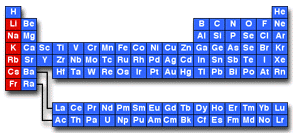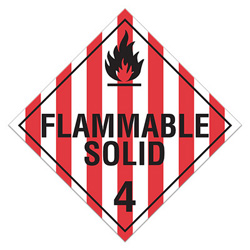



Find all of your laboratory and workplace safety supplies at Safety Emporium!
 Aliphatic |
 Glossary Index |
 Alkaline Earth |
| MSDS Topics |
Free Sites | FAQ's | Regulations | Glossary | Software | Suppliers |
| Books | Forum | Poll | Fun stuff | Quiz | Store | |
| Understand your MSDS with the MS-Demystifier | Search ALL our MSDS info | |||||
An alkali metal is any element other than hydrogen found in the first column of the periodic table. These elements include lithium (Li), sodium (Na), potassium (K), rubidium (Rb), cesium (Cs) and francium (Fr):


Be sure you're in compliance with DOT placards and labels from Safety Emporium.
Francium is a radioactive element that is highly unstable. It occurs in such minute amounts that it will not be discussed further.
In their elemental forms, the alkali metals are all soft, ductile, malleable substances that can be easily cut with a knife or drawn into a wire. Although these are shiny when cut, they almost immediately tarnish in air.
Alkali metals are quite reactive towards air and water, with increasingly dangerous reactivity as one moves down the column from Li to Cs. The reaction with water can be summarized by the chemical equation below where M = an alkali metal.
2 M(s) + 2 H2O  2 M+(aq) + 2 HO-(aq) + H2(g)
2 M+(aq) + 2 HO-(aq) + H2(g)
The heat generated by this reaction is sufficient in most cases to ignite the hydrogen gas (H2) that is evolved in the reaction. This can result in a powerful explosion depending on the amount and surface area of the alkali metal. Elemental potassium and cesium are particularly dangerous in this regard; even one gram can cause a serious hazard. When working with alkali metals, be sure you have a fire extinguisher that is approved for Class D fires.
Because of their water-reactive and/or pyrophoric nature, alkali metals are usually stored under an inert atmosphere and/or mineral oil. This also reduces the rate of formation of dangerous peroxides. Note: lithium should not be stored under nitrogen because the two can react to form lithium nitride, Li3N.
Finally, note there is a great difference between an alkali metal and an alkali metal cation. For example, (elemental) sodium metal, Na, is quite dangerous to work with, whereas sodium chloride (which contains the sodium cation, Na+, and chloride cation, Cl-) is common table salt. Then again, excessive dietary salt intake is associated with hypertension (high blood pressure).
Always use extreme caution when working with alkali metals. All equipment, solvents and chemicals need to be dry. Avoid contact with or storage near incompatible materials; for example, addition of sodium metal to carbon tetrachloride, other halogenated materials, or certain alcohols would lead to a catastrophic explosion.
Do not work with alkali metals unless you have had special training from someone who is experienced in working with these materials. Most accidents involving alkali metals tend to occur when one is cleaning up and "quenching" the alkali metal. Such procedures usually involve the use of flammable organic solvents, making such accidents quite severe. A proper Class D extinguisher should be available where alkali metals are utilized.
The Safety Data Sheet for alkali metals contains a host of information including fire-fighting measures, accidental release measures, precautions for safe handling/storage and more. Be sure to read an understand these SDSs fully!
The lithium ion (Li+) is a psychoactive agent so avoid inhalation or ingestion of lithium-containing materials by using proper personal protective equipment such as dust masks and gloves as well as engineering controls such as fume hoods. This information, if applicable, will be found in Section 11 (toxicological information) and Section 8 (exposure controls/personal protection) of the SDS. See below for links concerning the use of lithium in treating manic depression (bipolar disorder).

Flammable metals require special extinguishing agents such as Lith-X, which is the agent of choice for lithium fires.
See also: alkaline earth, halogen, inert, water reactive.
Additional definitions from Google and OneLook.
Entry last updated: Saturday, February 19, 2022. This page is copyright 2000-2025 by ILPI. Unauthorized duplication or posting on other web sites is expressly prohibited. Send suggestions, comments, and new entry desires (include the URL if applicable) to us by email.
Disclaimer: The information contained herein is believed to be true and accurate, however ILPI makes no guarantees concerning the veracity of any statement. Use of any information on this page is at the reader's own risk. ILPI strongly encourages the reader to consult the appropriate local, state and federal agencies concerning the matters discussed herein.